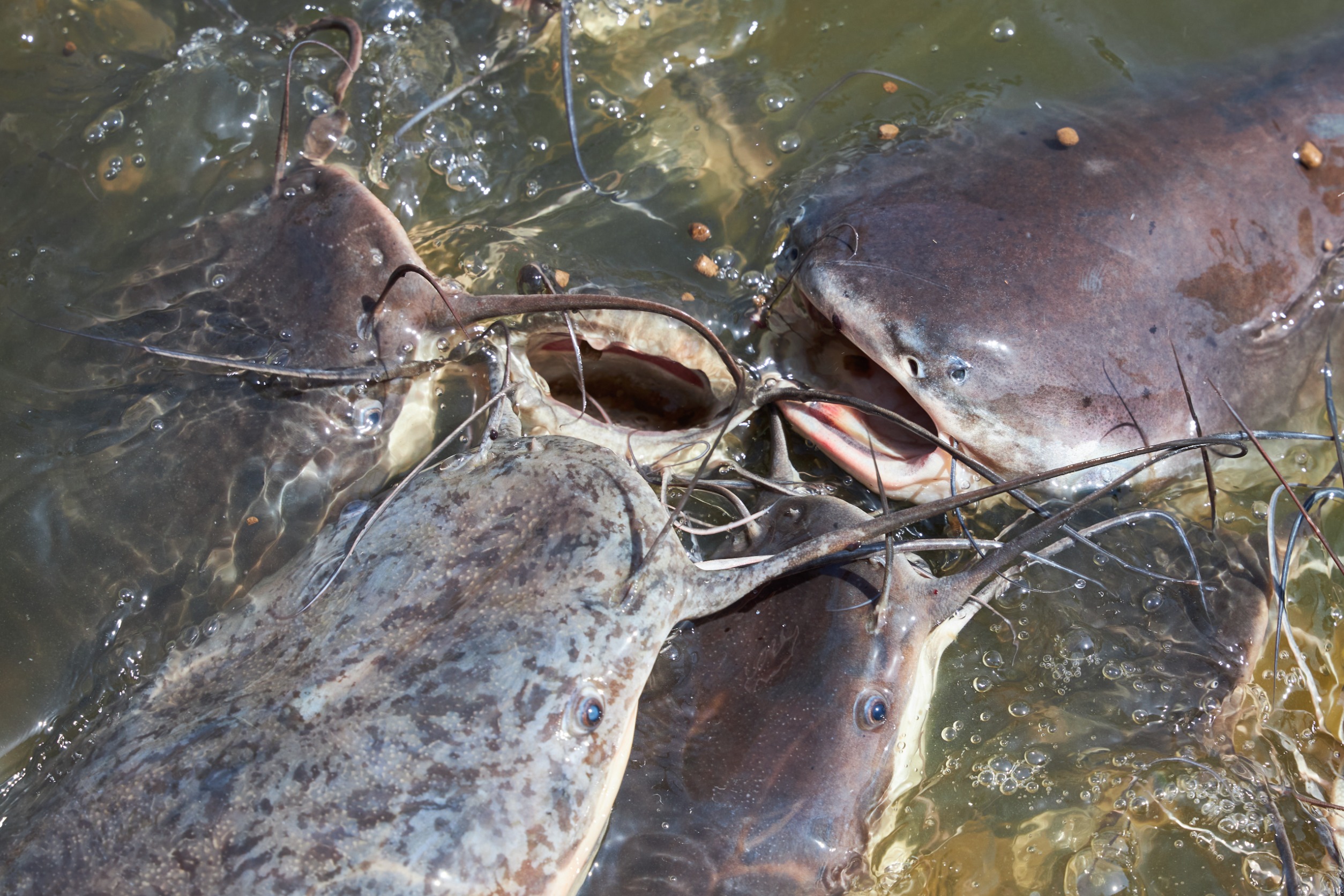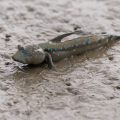Catfish use camouflage, spines, and distinctive behaviors such as pretending to be dead or producing a poisonous substance to avoid exploring and surviving in their aquatic surroundings.
Catfish are known for their sharp barbs and spines that they use to protect themselves from predators. These barbs and spines are on catfish’s dorsal, pectoral, and anal fins. When a catfish feels threatened, it will erect these fins to display its weaponry to potential predators.
How have catfish adapted to changing environments?
Catfish are a diverse species of fish that have adjusted to various aquatic conditions worldwide. Catfish have evolved numerous traits that have assisted them in changing habitats over millions of years.
Ability to live in low oxygen environments
Catfish’s capacity to thrive in minimal-oxygen conditions is one of their most impressive adaptations. Water bodies in various parts of the world become deficient in oxygen, making it harder for other fish species to live.
On the other hand, catfish have evolved a unique technique for surviving in low-oxygen situations. The swim bladder is an unusual organ that may operate as a lung, helping the fish breathe air. This means that catfish can survive underwater with extremely low oxygen levels by breathing in the air at the top of the water.
In addition to employing their swim bladder as a lung, certain catfish species have developed various adaptations to low-oxygen situations. For instance, the African electric catfish has a unique gill function that allows it to collect oxygen from the air.
Adaptation to fast-moving water
Some catfish species have developed the ability to survive in swiftly moving water. For example, the North American channel catfish may dwell in rivers with high currents. These fish have streamlined bodies that help them glide through the water with little effort. They also have huge fins that aid in maneuvering in swiftly moving water.
Adaptation to stagnant water
Some catfish populations are habituated to fast-moving water, whereas others have adapted to slow-moving water. Walking catfish, for example, can live in shallow, sluggish ponds and swamps in Southeast Asia. The labyrinth is a distinctive organ in these fish that helps them collect oxygen from the air. They can swim across the land with their pectoral fins, facilitating their movement between bodies of water in dry seasons.
Adaptation to low-light environments
Some catfish species are adapted to thrive in low-light settings such as ponds and rivers. These fish have survived by developing specialized senses, including electroreception and chemoreception, which aid in detecting prey in low-light environments. The electric catfish have specific cells on their bodies that can identify electrical signals generated by other food.
Reproductive adaptations
To secure the survival of their young, catfish have developed a variety of reproductive adaptations. Certain kinds of fish, such as channel catfish, lay their eggs in nests and protect them until the eggs hatch.
This shields the eggs from predators and increases the chances of survival for the larvae. Other species, such as blue catfish, lay their eggs on the river bottom, allowing them to flow downstream with the water. This aids in the dispersal of the eggs, improving the likelihood that some will survive.
Adaptation to changing temperatures
Climate change has caused temperature changes in bodies of water all across the planet. Catfish have adapted in a variety of ways to these altering conditions. Certain kinds of fish, such as the flathead catfish, have broad temperature resistance and may survive in warm and temperate waters. Other types of fish, such as blue catfish, have migrated to cooler waterways to stay out of the increasing temperatures.
Feeding habits
Catfish have a variety of feeding patterns, allowing them to thrive on a variety of food sources. Certain species are predators that eat other fish, while others are bottom feeders that eat debris and other organic substances. This adaptability in feeding patterns allows them to respond to changes in their surroundings.
Longevity
Some catfish populations have long life spans, allowing them to thrive in changing settings. For example, the Mekong catfish can live for as long as sixty years. It implies that they can adjust to changes in their surroundings over time, such as temperature variations, food availability, and habitat loss.

How do catfish defend themselves?
Catfish use several strategies to defend themselves from predators in their aquatic environments. Here are some ways that catfish protect themselves:
Camouflage
Catfish are well-known for their capacity to blend in with their surroundings through camouflage, which allows them to avoid detection by predators. Catfish are aquatic creatures that live on the bottom that use camouflage strategies to fit in with the sandy bottom and avoid being noticed.
Catfish use camouflage in various ways, including by adjusting the pattern and color of their bodies to their surroundings. Catfish have mottled skin, which helps them hide in rocks, sand, and other underwater objects. It allows them to avoid detection by enemies who hunt for prey using visual signals.
Catfish also employ camouflage by altering the color of their skin to fit with their surroundings. Certain catfish can vary their skin color by modifying the quantity of pigment in their skin cells. This enables them to blend in with their surroundings and prevent exploration by predators.
Catfish possess chromatophores, enabling them to adjust their skin pattern. Chromatophores are pigmented cells that can expand and shrink, permitting the catfish to modify the pattern on its skin. This enables the catfish to replicate the pattern of rocks, sand, and other aquatic stuff, making them hard to identify by predators.
Spines
Catfish have many sharp spines on their fins that they utilize for defense. The spines on their dorsal and pectoral fins are divided into two sorts.
The dorsal fin spine is usually the biggest and sharpest, employed chiefly for predator protection. When a catfish feels under attack, it can raise its dorsal fin, extending the sharp spine, making it harder for a predator to devour it. If necessary, the dorsal fin spine can be utilized to cause harm. Some catfish species contain poisonous spines on their dorsal fin, which can cause severe discomfort, swelling, and even paralysis if they come into contact with human or animal skin.
Although the pectoral fin spines are smaller than the dorsal fin spines, they can still inflict harm if misused. During the breeding season, these spines are positioned on the front edge of the pectoral fins to defend against predators or assert dominance over other catfish. Some catfish species have numerous spines on their pectoral fins, whereas others only have one.
It’s essential to remember that catfish typically utilize their spines as protection as a last resort, preferring to evade predators through camouflage and other protective techniques. Even so, if a catfish feels frightened or cornered, it may protect itself using its spines.
Unique behaviors: start
Some catfish species have developed protection measures beyond camouflage and sharp spines. These habits can assist them in avoiding predators or make them less appealing to possible predators. Here are two distinct catfish defensive methods:
Playing dead
Some catfish species, such as the ocellated cynodonts (Synodontis ocellifer), have been observed as “playing dead” when approached by a predator. When threatened, these catfish will roll onto their side and remain immobile, occasionally allowing themselves to be snatched up by the predator’s jaws.
The catfish will slowly straighten and disappear once the predator has moved out. This action is supposed to aid the catfish in avoiding predators hunting for live prey.
Emitting a toxin
Some catfish species, such as the walking catfish (Clarias batrachus), can produce poison from their skin when threatened. This poison, known as mucus toxin, can be damaging or even fatal to some predators.
Whenever walking catfish are outside of the water and feel threatened by a possible predatory animal, such as a bird or mammal, they frequently release poison. In some animals, the toxin may result in irritation, swelling, and even paralysis.
How do catfish use numbers to stay safe from predators?
Several catfish species can live in groups, which offers them a variety of advantages, such as protection from predators.
Catfish have numerous protective mechanisms that allow them to live in the environment. Catfish developed unique traits to protect themselves against predators and other hazards, including camouflage, armor, electric shocks, and group activity.
These defense systems aids in catfish survival and their interactions with others, ability to reproduce, and overall survival in changing settings.
Group Behavior in Catfish Start
Many catfish species are social and live in groups, such as channel catfish, blue catfish, and flathead catfish. They gather in schools or shoals of dozens to hundreds of individuals. These groups are frequently made up of fish of similar size and age.
Catfish join groups for a variety of reasons. One of the most crucial is predatory defense. Predators frequently target the least powerful or smallest members in a group; therefore, catfish can lower their predation risk by staying with a group.
The power of numbers
Whenever it concerns predator protection, being part of a group gives catfish various advantages. One of the most important is the power of numbers. Predators frequently use stealth and surprise to capture their prey. Catfish can notice predators faster and respond more effectively when they live in groups.
As a predator approaches a school of catfish, the fish usually scatter in various directions, which makes it harder for the predator to target a single individual. The “flash effect” describes this dispersion action, one of the most efficient ways catfish employ numbers to avoid predators.
Along with the flash effect, catfish employ their numbers to confuse and dominate attackers. Whenever a predator attacks a school of catfish, the fish frequently gather around the predator, producing a chaotic and perplexing environment.
This attitude makes it hard for the predator to focus on a single individual, increasing the likelihood that the predator will give up and pass on to easier prey.
Size Matters
The group size also influences how successful group behavior is for predator prevention in catfish. Larger groups offer more excellent safety than smaller ones. This is because larger groupings provide numerous eyes and fish to scatter and mislead the predator.
However, living in a large group has its own set of risks. Larger populations necessitate more resources, such as food and oxygen, and are more susceptible to diseases and parasites.
Why is the defense mechanism significant for catfish survival?
The defense mechanisms catfish use to play a crucial role in enabling them to thrive in their aquatic environments. Here are some reasons why:
Protection from predators
Catfish are preyed upon by various predators in their aquatic surroundings, including larger fish, birds, and mammals. Catfish escape being eaten by these carnivores by using camouflage, sharp spines, and distinctive defense actions such as feigning death or producing poisons.
Increased hunting success
Catfish are carnivores, and their camouflage and subtle movements allow them to hunt more successfully. Catfish can more readily approach their target by mixing in with the environment, thereby boosting the probability of a successful hunt.
Competition for resources
Many species compete for scarce resources such as food and shelter in congested aquatic habitats. Catfish can use camouflage and sharp spines to protect their area and resources from predators, boosting their chances of survival and effective reproduction.
Conclusion
To stay alive in their natural setting, catfish evolved various defense systems. These mechanisms include physical adaptations, including armor, spines, and camouflage, as well as behavioral adaptations, such as electric shocks and group behavior.
Catfish may safeguard themselves against predators and other risks by adopting these techniques, which increase their chances of survival. These defense systems are critical to catfish survival because they allow them to adapt to changing conditions and thrive in their natural habitats.











